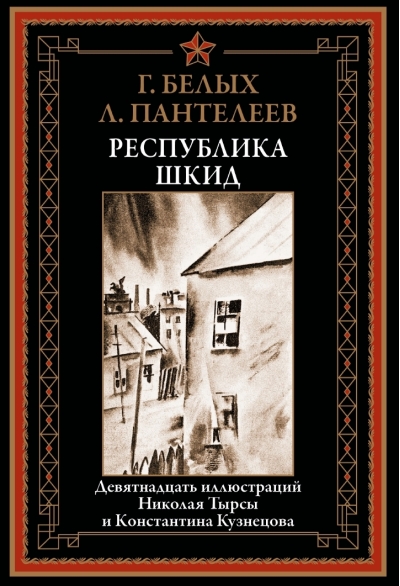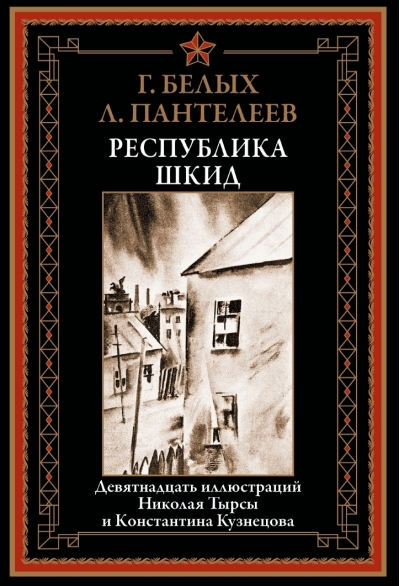Republic of SHKID
14.99 €
Out of stock
The adventure story "The Republic of Shkid" about the life of street children in the Dostoevsky School-Commune (Shkid) was first published in 1927. Its authors - G. G. Belykh (1906-1938) and A. I. Yeremeev (1908-1987), who wrote under the pseudonym L. Panteleyev - were homeless children themselves, so the story is partly autobiographical in nature. The edition also includes eighteen "shkid" stories by Panteleev and Belykh. The book is decorated with illustrations by the famous graphic artist N. A. Tyrsa (1887-1942).
The adventure story "The Republic of Shkid" about the life of street children in the Dostoevsky School-Commune (Shkid) was first published in 1927. Its authors - Grigory Belykh and Alexei Yeremeev (who wrote under the pseudonym A. Panteleyev) - were familiar with this topic firsthand. They themselves were as children homeless, so the story written by them has a partly autobiographical character. The fate of the authors turned out differently. Both became journalists, but Belykh died of tuberculosis in 1938, and Eremeev lived a long life, having managed to write many stories and fairy tales for children. He often returned in his work to the "Shkid" theme. It would seem that the problem of homelessness, so relevant in the early years after the revolution, has long gone into the past, but the reader's interest in "The Republic of Shkid" does not fade. The secret of the success of the story is that it tells not only about a difficult childhood, but also about human relationships, about the problems of socialization, about the formation in the soul of a small man corrosive concepts such as "conscience", "responsibility" and "duty", about the behavior of a child in a difficult life situation, about his search for his place in the adult world. These themes are eternal, they do not lose their relevance in our days. It is also important that the story is written cheerfully, with humor, it has many mischievous adventures. It is no coincidence that "The Republic of Shkid" was repeatedly reprinted and translated. The book is decorated with illustrations by Nikolai Andreevich Tyrsa (1887-1942), one of the founders of the Leningrad school of book graphics. He was taught the subtleties of craftsmanship by such coryphees of painting as Bakst and Dobuzhinsky. Nikolai Andreevich's creative interests were quite diverse. He was fond of studying Old Russian art, engaged in decorative painting of St. Petersburg mansions and industrial design, taught watercolor technique to students, but still the main love of his life was book illustrations. Tyrsa started doing them in the 20s of the last century. Before the war, he designed many books by Boris Zhitkov, drew illustrations for Pushkin's "Queen of Spades", Tolstoy's "Anna Karenina" and Lermontov's "The Hero of Our Time". Speaking about his illustrations for "The Republic of Shkid", L. Panteleev noted: "This is a very accurate realistic drawing with a subtle shade of grotesque. In short, it is the style of the story itself ... Shkidtsy drew and after Tyrsa - and at home and abroad, and no one has ever managed so faithfully, so easily, cheerfully and victoriously to capture not only the factuality, but also the very spirit of our homeless boyhood republic.
The adventure story "The Republic of Shkid" about the life of street children in the Dostoevsky School-Commune (Shkid) was first published in 1927. Its authors - Grigory Belykh and Alexei Yeremeev (who wrote under the pseudonym A. Panteleyev) - were familiar with this topic firsthand. They themselves were as children homeless, so the story written by them has a partly autobiographical character. The fate of the authors turned out differently. Both became journalists, but Belykh died of tuberculosis in 1938, and Eremeev lived a long life, having managed to write many stories and fairy tales for children. He often returned in his work to the "Shkid" theme. It would seem that the problem of homelessness, so relevant in the early years after the revolution, has long gone into the past, but the reader's interest in "The Republic of Shkid" does not fade. The secret of the success of the story is that it tells not only about a difficult childhood, but also about human relationships, about the problems of socialization, about the formation in the soul of a small man corrosive concepts such as "conscience", "responsibility" and "duty", about the behavior of a child in a difficult life situation, about his search for his place in the adult world. These themes are eternal, they do not lose their relevance in our days. It is also important that the story is written cheerfully, with humor, it has many mischievous adventures. It is no coincidence that "The Republic of Shkid" was repeatedly reprinted and translated. The book is decorated with illustrations by Nikolai Andreevich Tyrsa (1887-1942), one of the founders of the Leningrad school of book graphics. He was taught the subtleties of craftsmanship by such coryphees of painting as Bakst and Dobuzhinsky. Nikolai Andreevich's creative interests were quite diverse. He was fond of studying Old Russian art, engaged in decorative painting of St. Petersburg mansions and industrial design, taught watercolor technique to students, but still the main love of his life was book illustrations. Tyrsa started doing them in the 20s of the last century. Before the war, he designed many books by Boris Zhitkov, drew illustrations for Pushkin's "Queen of Spades", Tolstoy's "Anna Karenina" and Lermontov's "The Hero of Our Time". Speaking about his illustrations for "The Republic of Shkid", L. Panteleev noted: "This is a very accurate realistic drawing with a subtle shade of grotesque. In short, it is the style of the story itself ... Shkidtsy drew and after Tyrsa - and at home and abroad, and no one has ever managed so faithfully, so easily, cheerfully and victoriously to capture not only the factuality, but also the very spirit of our homeless boyhood republic.
See also:
- All books by the publisher
- All books by the author
- All books in the series Library of World Literature

















